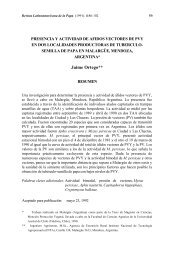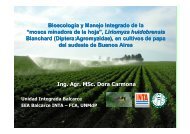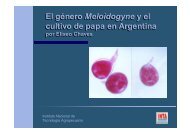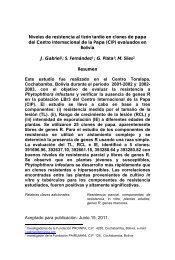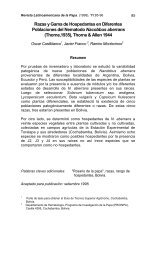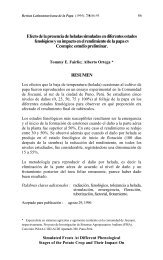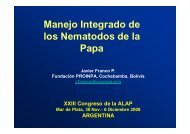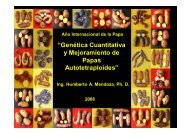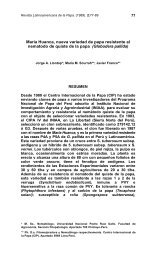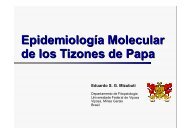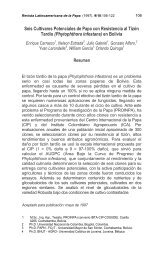infecciones mezcladas de virus de papa y sus efectos en la biologÃa ...
infecciones mezcladas de virus de papa y sus efectos en la biologÃa ...
infecciones mezcladas de virus de papa y sus efectos en la biologÃa ...
Create successful ePaper yourself
Turn your PDF publications into a flip-book with our unique Google optimized e-Paper software.
Infecciones <strong>mezc<strong>la</strong>das</strong> <strong>de</strong> <strong>virus</strong> <strong>de</strong> <strong>papa</strong> (PVY y PLRV) y <strong>sus</strong><br />
<strong>efectos</strong> <strong>en</strong> <strong>la</strong> biología <strong>de</strong> áfidos vectores y <strong>la</strong> epi<strong>de</strong>miología<br />
<strong>de</strong> <strong>virus</strong><br />
Juan Manuel Alvarez<br />
Departm<strong>en</strong>t of P<strong>la</strong>nt, Soil and<br />
Entomological Sci<strong>en</strong>ces<br />
Aber<strong>de</strong><strong>en</strong> R&E C<strong>en</strong>ter
• El Pacifico Noroeste produce cerca <strong>de</strong>l 61% <strong>de</strong> <strong>la</strong>s <strong>papa</strong>s<br />
<strong>de</strong> los Estados Unidos<br />
• Idaho es el mayor productor (32%) con mas <strong>de</strong> 142,200<br />
ha cosechadas <strong>en</strong> el 2007 (NASS 2008)
Dos <strong>virus</strong> <strong>de</strong> <strong>papa</strong> que son transmitidos por áfidos<br />
Potato Leafroll Virus<br />
Potato Virus Y<br />
(Luteoviridae: Polero<strong>virus</strong>)<br />
(Potyviridae: Poty<strong>virus</strong>)<br />
Áfidos colonizadores Áfidos colonizadores y no-colonizadores<br />
Reduc<strong>en</strong> drásticam<strong>en</strong>te <strong>la</strong> cosecha y<br />
también <strong>la</strong> calidad. RB (62%) es muy<br />
<strong>sus</strong>ceptible a <strong>la</strong> necrosis <strong>de</strong> maya y<br />
también a algunos círculos necróticos
PVY <strong>en</strong> <strong>papa</strong><br />
• Las razas O causan moteado <strong>de</strong> hojas y<br />
síntomas secundarios incluy<strong>en</strong>do<br />
arrugami<strong>en</strong>to <strong>de</strong> hojas y <strong>en</strong>anismo<br />
• Las razas N causan principalm<strong>en</strong>te<br />
síntomas <strong>de</strong> mosaico que es difícil <strong>de</strong><br />
<strong>de</strong>tectar <strong>en</strong> <strong>la</strong> mayoría <strong>de</strong> cultivares (1990<br />
= primera epi<strong>de</strong>mia)<br />
• Algunos ais<strong>la</strong>mi<strong>en</strong>tos <strong>de</strong> N produc<strong>en</strong><br />
círculos superficiales que luego se vuelv<strong>en</strong><br />
profundos y necróticos (almac<strong>en</strong>aje).<br />
Estos han sido c<strong>la</strong>sificados como NTN<br />
• La pres<strong>en</strong>cia <strong>de</strong> N fue confirmada por<br />
primera vez <strong>en</strong> el PNO <strong>en</strong> el 2001<br />
(Crosslin et al. 2006)
PVY Recombinantes= PVY N:O<br />
• Algunos ais<strong>la</strong>mi<strong>en</strong>tos ti<strong>en</strong><strong>en</strong><br />
características <strong>de</strong> ambas razas O y N.<br />
Se les ha l<strong>la</strong>mado N:O porque<br />
serológicam<strong>en</strong>te son c<strong>la</strong>sificadas como<br />
O pero produc<strong>en</strong> necrosis <strong>en</strong> tabaco.<br />
• La mayoría causan círculos necróticos<br />
<strong>en</strong> los tubérculos<br />
• La pres<strong>en</strong>cia <strong>de</strong> N:O fue también<br />
confirmada <strong>en</strong> el PNO (Crosslin et al.<br />
2006)
Esc<strong>en</strong>ario actual <strong>de</strong> PVY<br />
Idaho<br />
% lotes rechazados<br />
2001 2002 2003 2004 2005 2006 2007<br />
- Courtesy Gl<strong>en</strong>da Craig, Idaho Crop Improvem<strong>en</strong>t<br />
Association, Inc.
Semil<strong>la</strong> libre <strong>de</strong> <strong>virus</strong><br />
• Para po<strong>de</strong>r ser certificado <strong>en</strong> Idaho, los lotes importados <strong>de</strong>b<strong>en</strong> haber<br />
pasado <strong>la</strong> prueba <strong>de</strong> invierno o los brotes haber sido probados con ELISA.<br />
• PLRV pue<strong>de</strong> ser visual o ELISA. Máximo <strong>virus</strong> permitido para po<strong>de</strong>r ser recertificado<br />
es:<br />
• PLRV: 0.8%<br />
• Mosaico (PVY + PVA): 2.0%<br />
G<strong>en</strong>eration Tolerance limit %<br />
Nuclear 0.00<br />
G1 0.00<br />
G2 0.25<br />
G3 0.50<br />
G4 0.75<br />
G5 1.00<br />
G6 1.00<br />
- Courtesy Gl<strong>en</strong>da Craig, Idaho Crop Improvem<strong>en</strong>t<br />
Association, Inc.
Una trilogía inseparable<br />
Virus<br />
Efici<strong>en</strong>cia <strong>de</strong> transmisión y<br />
especificidad <strong>de</strong>l vector<br />
Reacc ión <strong>de</strong>l<br />
huésped y rango<br />
<strong>de</strong> hospe<strong>de</strong>ros<br />
P<strong>la</strong>nta Virus Vector Virus<br />
Ecología y clima, f<strong>en</strong>otipo y<br />
g<strong>en</strong>otipo y comportami<strong>en</strong>to <strong>de</strong><br />
alim<strong>en</strong>tación<br />
- Carter 1939; Hull 1991
Virus Transmission by Aphids<br />
No-persist<strong>en</strong>te<br />
Persist<strong>en</strong>te<br />
(PVY)<br />
(PLRV)
Transmisión no persist<strong>en</strong>te<br />
Adquisición Ret<strong>en</strong>ción Inocu<strong>la</strong>ción<br />
Segundos a<br />
minutos<br />
Segundos a<br />
minutos<br />
No hay periodo<br />
<strong>la</strong>t<strong>en</strong>te<br />
Transmisión persist<strong>en</strong>te<br />
Adquisición Ret<strong>en</strong>ción Inocu<strong>la</strong>ción<br />
Minutos a<br />
horas<br />
De por vida<br />
Un periodo <strong>la</strong>t<strong>en</strong>te<br />
necesario (horasdias)
Transmisión no persist<strong>en</strong>te<br />
• Hipótesis <strong>de</strong> ingestión-egestión (Harris 1980) 140 µm<br />
• Hipótesis <strong>de</strong> ingestión-salivación (Martin et al.1997) 10 µm<br />
• < 5 µm (Uzest et al. 2007. Proc. Natl. Acad. Sci. 104: 17959-17964)<br />
Cauliflower mosaic particle <strong>virus</strong><br />
particles binding to Brevicoryne<br />
brassica stylets – illuminated upon<br />
GFP fusion
Vectores <strong>de</strong> PVY<br />
Myzus persicae<br />
Macrosiphum euphorbiae<br />
Rhopalosiphum padi
1500<br />
Especies <strong>de</strong> afidos capturadas <strong>en</strong> Rexburg<br />
1000<br />
500<br />
0<br />
7/2/06<br />
7/7/06<br />
7/1 2/06<br />
7/1 7/06<br />
7/2 2/06<br />
7/2 7/06<br />
8/1/06<br />
8 /6/06<br />
8 /1 1/0 6<br />
8/1 6/06<br />
Bird Cherry Oat Aphid Rose-Grass Aphid Russian Olive Aphid Other species (13)<br />
# A p h i d s
Transmisión no persist<strong>en</strong>te
Transmisión persist<strong>en</strong>te (PLRV)<br />
Persist<strong>en</strong>t <strong>virus</strong> transported through hindgut- haemolymph/haemoceo<strong>la</strong>ccessory<br />
salivary g<strong>la</strong>nds
Vectores <strong>de</strong> PLRV<br />
Myzus persicae<br />
Macrosiphum euphorbiae
Las <strong>infecciones</strong> virales afectan <strong>la</strong> prefer<strong>en</strong>cia <strong>de</strong><br />
los áfidos por <strong>sus</strong> p<strong>la</strong>ntas hospe<strong>de</strong>ras<br />
• Las c<strong>la</strong>ves visuales han sido implicadas<br />
ya que los áfidos prefier<strong>en</strong> el color<br />
amarillo y <strong>la</strong> clorosis es un síntoma <strong>de</strong><br />
infección <strong>de</strong> muchos <strong>virus</strong> (Moericke 1955,<br />
K<strong>en</strong>nedy et al. 1961, Macias and Mink 1969, Fereres<br />
et al. 1999)<br />
Infección por<br />
Luteo<strong>virus</strong><br />
Infección por<br />
Poty<strong>virus</strong>
• Las c<strong>la</strong>ves olfatorias también han sido<br />
implicadas <strong>en</strong> <strong>la</strong> atracción (Purcell and Nault<br />
1991, Castle and Berger 1993, Castle et al. 1998)<br />
• VIV (Eig<strong>en</strong>bro<strong>de</strong> et al, 2002)
30<br />
Emigración <strong>de</strong>l AVD<br />
Mean No. of aphids<br />
25<br />
20<br />
15<br />
10<br />
5<br />
HNS vs Potato P < 0.0001<br />
PLRV-inf vs Non-inf P < 0.0001<br />
Potato-Non.inf<br />
HNS-Non.inf<br />
HNS-PLRV<br />
Potato-PLRV<br />
0<br />
10 20 30 40 50 60<br />
Time interval (min)<br />
- Srinivasan et al. 2006: Environ. Entomol.
Comparando y cuantificando los volátiles<br />
emitidos por p<strong>la</strong>ntas infectadas y sanas<br />
Vo<strong>la</strong>tile collection apparatus
So<strong>la</strong>num sarrachoi<strong>de</strong>s VOCs<br />
45<br />
40<br />
HNS-PLRV vs HNS non-infected P = 0.0406<br />
ng/100g dry tissue<br />
35<br />
30<br />
25<br />
20<br />
15<br />
10<br />
5<br />
0<br />
GLVs nonanol methyl salicy<strong>la</strong>te tri<strong>de</strong>cane<br />
HNS non-infected<br />
HNS PLRV
Terp<strong>en</strong>oi<strong>de</strong>s <strong>de</strong> <strong>papa</strong> (sesquiterp<strong>en</strong>os)<br />
α-murrrol<strong>en</strong>e<br />
uksq<br />
uksq<br />
uksq<br />
germacr<strong>en</strong>e<br />
7-11-dimethyl-3-do<strong>de</strong>catri<strong>en</strong>e<br />
α- caryophyll<strong>en</strong>e<br />
β-sesquiphel<strong>la</strong>ndr<strong>en</strong>e<br />
caryophyll<strong>en</strong>e<br />
Uksq<br />
α- cubab<strong>en</strong>e<br />
γ-elem<strong>en</strong>e<br />
β-myrc<strong>en</strong>e<br />
0 500 1000 1500 2000 2500 3000 3500 4000 4500<br />
ng/100g of dry tissue<br />
Potato PLRV Potato non-infected
Efecto <strong>de</strong> los <strong>virus</strong> <strong>en</strong> <strong>la</strong><br />
biología <strong>de</strong> los vectores<br />
• Infecciones virales alteran <strong>la</strong> fisiología <strong>de</strong> <strong>la</strong> p<strong>la</strong>nta<br />
hospe<strong>de</strong>ra<br />
• Increm<strong>en</strong>ta <strong>la</strong> acumu<strong>la</strong>ción <strong>de</strong> nutri<strong>en</strong>tes como<br />
aminoácidos y carbohidratos (Ajayi 1986, Fererres et al. 1990)<br />
• Increm<strong>en</strong>to <strong>en</strong> <strong>la</strong> producción <strong>de</strong> nutri<strong>en</strong>tes resulta<br />
<strong>en</strong> b<strong>en</strong>eficios para los áfidos<br />
• A m<strong>en</strong>udo re<strong>la</strong>cionados con <strong>virus</strong> que son<br />
transmitidos persist<strong>en</strong>tem<strong>en</strong>te
Parámetros biológicos <strong>de</strong>l AFD y <strong>de</strong>l AP<br />
1. Papa - PLRV<br />
2. Papa<br />
Myzus persicae<br />
12 repeticiones /tratami<strong>en</strong>to<br />
Macrosiphum euphorbiae<br />
Fecundidad, longevidad, periodo reproductivo y tasa intrínseca<br />
<strong>de</strong> crecimi<strong>en</strong>to
Inocu<strong>la</strong>ción <strong>de</strong>l PLRV<br />
Physalis<br />
floridana -<br />
PLRV<br />
CT-p<strong>la</strong>ntu<strong>la</strong>s <strong>de</strong> <strong>papa</strong><br />
Repollo<br />
Chino<br />
(DAS ELISA)
Parámetros biológicos <strong>de</strong>l AFD y <strong>de</strong>l AP<br />
Fecundidad<br />
Longevidad<br />
Srinivasan et al. 2008. Environ. Entomol.
Parámetros biológicos <strong>de</strong>l AFD y <strong>de</strong>l AP<br />
Periodo reproductivo<br />
Tasa intrínseca <strong>de</strong> crecimi<strong>en</strong>to<br />
Srinivasan et al. 2008. Environ. Entomol.
Infecciones virales <strong>mezc<strong>la</strong>das</strong><br />
Coinfección con dos <strong>virus</strong> PVY y PLRV<br />
50<br />
45<br />
Pruebas <strong>de</strong> Invierno<br />
% of infection<br />
40<br />
35<br />
30<br />
25<br />
20<br />
15<br />
10<br />
5<br />
0<br />
PVY PLRV PVY-PLRV
Infecciones virales <strong>mezc<strong>la</strong>das</strong> (información<br />
previa)<br />
• Varios autores han investigado ext<strong>en</strong>sivam<strong>en</strong>te<br />
el f<strong>en</strong>óm<strong>en</strong>o <strong>de</strong> <strong>la</strong>s <strong>infecciones</strong> <strong>mezc<strong>la</strong>das</strong> sobre<br />
<strong>la</strong>s p<strong>la</strong>ntas (Rochow & Ross 1955, Barker 1989, Jayasinghe et al.<br />
1989, Fereres et al. 1990, Vance 1991, Vance et al. 1995, Scheets<br />
1998, Karyeija et al. 2000, Sav<strong>en</strong>kov & Valkon<strong>en</strong> 2001)<br />
• Muy pocos estudios con <strong>virus</strong> <strong>de</strong> tejidos no<br />
específicos (poti<strong>virus</strong>) y específicos (luteo<strong>virus</strong>)<br />
• No se ha estudiado el efecto <strong>de</strong> <strong>la</strong>s mezc<strong>la</strong>s<br />
sobre <strong>la</strong> biología <strong>de</strong>l vector y <strong>la</strong> prefer<strong>en</strong>cia
Efecto <strong>de</strong> <strong>la</strong>s Infecciones virales <strong>mezc<strong>la</strong>das</strong><br />
4 tratami<strong>en</strong>tos<br />
1. Papa No-inf.<br />
2. PVY-infectada<br />
3. PLRV-infectada<br />
4. PVY-PLRV<br />
infectada<br />
12 repeticiones /tratami<strong>en</strong>to<br />
Fecundidad monitoreada <strong>de</strong>spués <strong>de</strong> 96 horas
20<br />
Fecundidad<br />
P < 0.0001<br />
P < 0.1208<br />
15<br />
nymphs / female<br />
10<br />
5<br />
0<br />
Non-inf. PVY PLRV PVY-PLRV<br />
- Srinivasan & Alvarez 2007. J. Econ. Entomol.
Prefer<strong>en</strong>cia <strong>de</strong> a<strong>la</strong>dos<br />
1<br />
2<br />
3<br />
4<br />
1. No-infectada<br />
2. PVY infectada<br />
3. PLRV-infectada<br />
4. PVY-PLRV infectada<br />
Srinivasan et al. 2006. Environ. Entomol.
Prefer<strong>en</strong>cia <strong>de</strong> apteros<br />
Prefer<strong>en</strong>cia medida <strong>en</strong><br />
<strong>la</strong> oscuridad (el tubo<br />
se cubrió con papel<br />
aluminio)<br />
Castle et al. 1998<br />
Srinivasan et al. 2006. Environ. Entomol.
Prefer<strong>en</strong>cia <strong>de</strong> apteros<br />
# of GPA<br />
60<br />
50<br />
40<br />
30<br />
20<br />
10<br />
La prefer<strong>en</strong>cia no fue<br />
difer<strong>en</strong>te <strong>en</strong> oscuridad y<br />
<strong>en</strong> <strong>la</strong> pres<strong>en</strong>cia <strong>de</strong> luz<br />
P < 0.0001<br />
P < 0.0001<br />
0<br />
Non-inf. PVY PLRV PVY-PLRV<br />
- Srinivasan & Alvarez 2007. J. Econ. Entomol.
Prefer<strong>en</strong>cia <strong>de</strong> a<strong>la</strong>dos<br />
25<br />
P < 0.0143<br />
P < 0.0462<br />
20<br />
# of GPA<br />
15<br />
10<br />
5<br />
0<br />
Non-inf. PVY PLRV PVY-PLRV<br />
- Srinivasan & Alvarez 2007. J. Econ. Entomol.
PLRV<br />
Tres hipótesis<br />
PVY<br />
PVY-<br />
PLRV<br />
1. La interacción<br />
sinergistica mediada<br />
por el HC-Pro con <strong>virus</strong><br />
no-poti<strong>virus</strong> pue<strong>de</strong>n<br />
suprimir mecanismos<br />
<strong>de</strong> sil<strong>en</strong>ciami<strong>en</strong>to <strong>de</strong><br />
g<strong>en</strong>omas invasores <strong>de</strong><br />
<strong>la</strong>s p<strong>la</strong>ntas (PTGS;<br />
Ananda<strong>la</strong>kshmi et al.<br />
1997).<br />
2. Esto pue<strong>de</strong> llevar a <strong>la</strong><br />
expresión severa <strong>de</strong><br />
síntomas y alteración<br />
<strong>de</strong> titulos: el titulo <strong>de</strong><br />
ambos <strong>virus</strong> se redujo<br />
<strong>en</strong> <strong>la</strong>s p<strong>la</strong>ntas con<br />
infeccion mezc<strong>la</strong>da<br />
(16% para PVY y 33%<br />
para PLRV)<br />
3. El increm<strong>en</strong>to <strong>en</strong> <strong>la</strong> <strong>sus</strong>ceptibilidad pue<strong>de</strong> aum<strong>en</strong>tar <strong>la</strong> producción <strong>de</strong> c<strong>la</strong>ves<br />
<strong>de</strong> stress o volátiles inducidos por <strong>la</strong> infección (Eig<strong>en</strong>bro<strong>de</strong> et al. 2002)
proporción <strong>de</strong> razas necróticas y recombinantes también <strong>en</strong> NA<br />
(Piche et al. 2004; Crosslin et al. 2005).<br />
Biological/serological data<br />
Molecu<strong>la</strong>r data<br />
Porc<strong>en</strong>taje <strong>de</strong> N y O<br />
100<br />
80<br />
60<br />
40<br />
20<br />
1930<br />
1937<br />
1944<br />
1951<br />
PVY O<br />
1958<br />
1965<br />
France<br />
= PVY O + PVY N -W<br />
PVY N = PVY N + PVY NTN<br />
1972<br />
1979<br />
1986<br />
1993<br />
PVY N<br />
2000<br />
Necrotic<br />
PVY O<br />
PVY N -W<br />
PVY NTN<br />
PVY N<br />
2005<br />
France<br />
Necrotic<br />
PVY N -W<br />
PVY NTN<br />
2002<br />
Germany<br />
PVY O<br />
Determinar si existe alguna especificidad <strong>en</strong>tre <strong>la</strong>s razas <strong>de</strong>l PVY y los<br />
vectores<br />
PVY N
Porc<strong>en</strong>taje <strong>de</strong> infección 3 semanas<br />
<strong>de</strong>spués <strong>de</strong> <strong>la</strong> inocu<strong>la</strong>ción con áfidos<br />
100<br />
% o f i n f e c t i o n<br />
80<br />
60<br />
40<br />
20<br />
0<br />
PVYO PVYN:O PVYNTN<br />
HNS<br />
Potato
n g v iru s<br />
Titulo <strong>de</strong> PVY 3 semanas <strong>de</strong>spués <strong>de</strong> <strong>la</strong><br />
inocu<strong>la</strong>ción con áfidos<br />
4<br />
3.5<br />
3<br />
2.5<br />
2<br />
1.5<br />
1<br />
0.5<br />
0<br />
a<br />
PVYO PVYN:O PVYNTN<br />
HNS<br />
Potato<br />
b
Interacciones <strong>de</strong> áfidos con razas necróticas y<br />
no necróticas<br />
Inocu<strong>la</strong>ción mecánica<br />
Inocu<strong>la</strong>ción con áfidos<br />
PVY O PVY N:O<br />
PVY NTN<br />
% infección<br />
Razas fueron distinguidas<br />
usando el RT-PCR multiplex
Conclusiones<br />
• C<strong>la</strong>ves visuales y olfatorias <strong>de</strong> p<strong>la</strong>ntas afectadas<br />
afectan <strong>la</strong> biología <strong>de</strong> los vectores e increm<strong>en</strong>tan <strong>la</strong><br />
atracción <strong>de</strong> dichos vectores<br />
• Estos b<strong>en</strong>eficios <strong>en</strong> los vectores a su vez ayudan a<br />
propagar los <strong>virus</strong> y aum<strong>en</strong>tar <strong>la</strong>s tasas <strong>de</strong> infección<br />
<strong>en</strong> campo<br />
• La re<strong>la</strong>ción <strong>en</strong>tre PVY y <strong>sus</strong> vectores parece ser<br />
específica <strong>de</strong> acuerdo a <strong>la</strong> raza <strong>de</strong>l <strong>virus</strong> y a <strong>la</strong><br />
especie <strong>de</strong>l vector.<br />
• Las razas <strong>de</strong> PVY necróticas parec<strong>en</strong> ser mas<br />
fácilm<strong>en</strong>te transmitidas que <strong>la</strong>s otras razas<br />
• Esto pue<strong>de</strong> explicar el increm<strong>en</strong>to <strong>de</strong> infección <strong>de</strong><br />
razas necróticas <strong>en</strong> muchos países productores <strong>de</strong><br />
<strong>papa</strong>
Agra<strong>de</strong>cimi<strong>en</strong>tos<br />
-Dr. Marcelo Huarte<br />
-Dr. Babu Srinivasan<br />
-Felix Cervantes (Ph.D. Stu<strong>de</strong>nt)<br />
-Drs. Crosslin & Whitworth<br />
-Apoyo técnico: H. Libby, M.<br />
Wiebe, Y. Medina, E. Dotseth<br />
-Colegas <strong>en</strong> Idaho: Drs. N.<br />
Bosque-Pérez, S. Eig<strong>en</strong>bro<strong>de</strong>,<br />
P. Hutchinson, J. Whitworth<br />
-Fondos fe<strong>de</strong>rales <strong>en</strong> los EEUU
• ¡Buscando bu<strong>en</strong>os estudiantes que estén<br />
interesados <strong>en</strong> este tipo <strong>de</strong> investigación!<br />
• jalvarez@uidaho.edu



